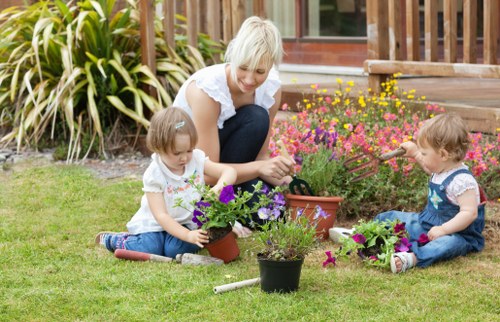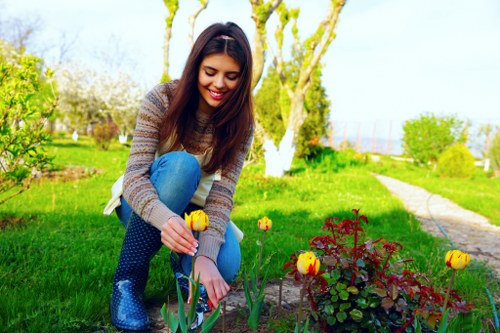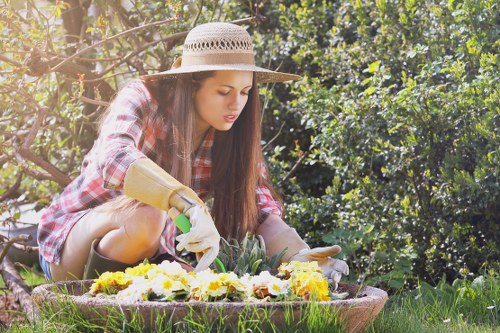Transforming Barbican: Expert Landscape Gardening Tips
Introduction to Landscape Gardening in Barbican

Landscape gardening in Barbican is an art that combines aesthetic appeal with functionality, creating outdoor spaces that are both beautiful and practical. Whether you have a spacious garden or a modest balcony, thoughtful landscape design can significantly enhance the environment, providing a peaceful retreat and increasing the value of your property.
Barbican, known for its unique blend of modern architecture and historic charm, offers a perfect backdrop for creative landscape gardening. The area's climate, soil conditions, and community preferences play a vital role in shaping the gardening trends and practices adopted by enthusiasts and professionals alike.
In this comprehensive guide, we will explore the essential aspects of landscape gardening in Barbican, offering insights into design principles, plant selection, maintenance tips, and innovative ideas to transform your outdoor space into a stunning masterpiece.
Understanding the Barbican Climate and Soil

Successful landscape gardening starts with a deep understanding of the local climate and soil conditions. Barbican experiences a temperate maritime climate, characterized by mild winters and cool summers. This climate is conducive to a wide variety of plants, allowing gardeners to experiment with diverse flora.
The soil in Barbican varies, but it is generally well-draining with a good mix of nutrients. Conducting a soil test can provide valuable information about pH levels and nutrient content, enabling gardeners to amend the soil as needed for optimal plant growth.
Adapting your garden design to suit the climatic conditions ensures that your plants thrive throughout the year. Incorporating elements like shade structures, windbreaks, and proper irrigation systems can mitigate adverse weather effects and create a more resilient garden.
Design Principles for Barbican Gardens

When designing a landscape garden in Barbican, it’s essential to balance aesthetics with functionality. Here are some key design principles to consider:
- Harmony and Balance: Ensure that the elements of your garden complement each other, creating a cohesive look.
- Variety: Incorporate a mix of plant types, colors, and textures to add visual interest.
- Scale and Proportion: Choose plants and garden features that are appropriately scaled to your outdoor space.
- Sustainability: Use eco-friendly practices and native plants to promote a sustainable garden.
- Accessibility: Design pathways and seating areas that are easily accessible and encourage exploration.
Implementing these principles can help you create a garden that is not only beautiful but also functional and sustainable.
Choosing the Right Plants for Barbican

Selecting the appropriate plants is crucial for a thriving landscape garden in Barbican. Consider the following categories when choosing plants:
- Native Plants: These plants are well-adapted to the local climate and soil, requiring less maintenance and water.
- Perennials vs. Annuals: Perennials provide long-term structure to your garden, while annuals offer seasonal color and variety.
- Shade-Tolerant Plants: Ideal for areas with limited sunlight, these plants can thrive under trees or in covered spaces.
- Drought-Resistant Plants: Perfect for water-wise gardens, these plants require minimal irrigation once established.
- Flowering Plants: Add vibrant colors and attract pollinators, enhancing the garden’s biodiversity.
By carefully selecting plants that suit your garden’s conditions and your personal preferences, you can create a vibrant and resilient landscape.
Hardscaping Elements

Incorporating hardscaping elements like paths, patios, and walls can add structure and functionality to your garden. These features not only enhance the aesthetic appeal but also provide practical benefits such as defining spaces and facilitating movement.
Materials commonly used in Barbican gardens include natural stone, brick, and timber. Choosing high-quality, durable materials ensures that your hardscape elements withstand the test of time and weather conditions.
Integrating hardscaping with softscaping creates a harmonious balance, making your garden more inviting and versatile.
Water Features and Irrigation
Water features like fountains, ponds, and waterfalls add a sense of tranquility and movement to your landscape garden. They can serve as focal points, enhancing the overall ambiance and attracting wildlife.
Efficient irrigation systems are essential for maintaining healthy plants, especially during dry spells. Drip irrigation and rainwater harvesting are sustainable options that conserve water while ensuring your garden receives the necessary hydration.
Properly designed water management not only supports plant health but also contributes to the garden’s ecological balance.
Lighting for Your Garden
Illuminating your landscape garden extends its usability into the evening hours and highlights its best features. Outdoor lighting can create dramatic effects, enhance safety, and provide a warm ambiance.
Consider a mix of ambient, task, and accent lighting to achieve a balanced and functional lighting scheme. Solar-powered lights are an eco-friendly option that reduces energy consumption.
Strategically placed lighting can transform your garden, making it a magical space after dusk.
Maintenance Tips for Barbican Gardens
Regular maintenance is key to keeping your landscape garden in top condition. Here are some essential maintenance tasks:
- Pruning and Trimming: Keep plants healthy and shaped by regularly pruning and trimming.
- Weeding: Remove unwanted weeds to prevent them from competing with your plants for nutrients.
- Mulching: Apply mulch to retain moisture, regulate soil temperature, and suppress weed growth.
- Fertilizing: Provide essential nutrients to your plants through appropriate fertilization.
- Pest and Disease Control: Monitor your garden for signs of pests and diseases, addressing issues promptly and naturally when possible.
Consistent maintenance ensures that your garden remains healthy and continues to thrive throughout the seasons.
Seasonal Gardening in Barbican
Adapting your gardening practices to the changing seasons helps maintain the vitality and beauty of your landscape garden. Here’s how to approach gardening in each season:
- Spring: Plant new annuals, prune shrubs, and prepare beds for the growing season.
- Summer: Focus on watering, mulching, and managing heat-related plant stress.
- Autumn: Harvest vegetables, plant bulbs for spring, and prepare plants for colder weather.
- Winter: Protect delicate plants from frost, plan new garden layouts, and perform tool maintenance.
By aligning your gardening activities with seasonal changes, you can ensure a productive and attractive garden all year round.
Incorporating Sustainability in Landscape Gardening
Sustainable landscape gardening practices benefit both your garden and the environment. Here are some approaches to consider:
- Native Plants: Reduce water usage and support local wildlife by choosing native species.
- Composting: Turn garden waste into valuable compost, enhancing soil fertility naturally.
- Rainwater Harvesting: Collect and store rainwater for irrigation, minimizing reliance on municipal water sources.
- Organic Gardening: Avoid synthetic chemicals by using organic fertilizers and pest control methods.
- Energy-Efficient Lighting: Opt for solar-powered or LED lights to reduce energy consumption.
Implementing sustainable practices fosters a healthy ecosystem and aligns your gardening efforts with environmental conservation.
Creating a Wildlife-Friendly Garden
A wildlife-friendly garden supports biodiversity and creates a vibrant ecosystem. Here’s how to make your landscape garden in Barbican inviting to various creatures:
- Plant Diversity: Incorporate a variety of plant species to provide food and habitat for different wildlife.
- Water Sources: Install birdbaths, ponds, or other water features to attract birds and amphibians.
- Shelter and Nesting Sites: Provide structures like birdhouses, bee hotels, and log piles for shelter.
- Pest Control: Encourage beneficial insects and use natural pest control methods to maintain a balanced ecosystem.
- Minimize Pesticide Use: Reducing chemical usage protects beneficial wildlife and promotes a healthier garden environment.
By fostering a wildlife-friendly environment, your garden becomes a lively and dynamic space that benefits both plants and animals.
Utilizing Vertical Gardening Techniques
Vertical gardening is an innovative way to maximize space, especially in urban settings like Barbican. It involves growing plants upwards using structures such as trellises, walls, and containers.
Benefits of vertical gardening include:
- Space Efficiency: Ideal for small gardens, balconies, and patios.
- Enhanced Aesthetics: Adds visual interest and depth to your garden.
- Improved Plant Health: Better air circulation and sunlight exposure can promote healthier growth.
- Ease of Maintenance: Plants are more accessible for watering, pruning, and harvesting.
Incorporating vertical gardening into your landscape design can transform underutilized vertical spaces into lush, productive garden areas.
Choosing the Right Garden Furniture
Garden furniture plays a significant role in the functionality and comfort of your landscape garden. When selecting outdoor furniture for Barbican gardens, consider the following:
- Material Durability: Choose materials like teak, metal, or synthetic wicker that can withstand outdoor conditions.
- Comfort: Select furniture that offers comfort for extended outdoor use.
- Style Consistency: Ensure that the furniture complements your garden’s overall design and theme.
- Space Optimization: Opt for furniture that fits well within your garden space without causing clutter.
- Maintenance: Consider easy-to-clean and low-maintenance options to simplify upkeep.
Appropriately chosen garden furniture enhances the usability and appeal of your outdoor space, making it a welcoming area for relaxation and socializing.
Integrating Art and Sculptures
Art installations and sculptures can add a unique and personalized touch to your landscape garden. They serve as focal points and conversation starters, enriching the garden’s visual appeal.
When incorporating art into your garden, consider:
- Theme Consistency: Choose pieces that align with your garden’s design and aesthetic.
- Placement: Strategically position art to highlight specific areas or views within the garden.
- Material Selection: Select weather-resistant materials to ensure longevity and durability.
- Scale and Proportion: Ensure that the size of the art pieces complements the surrounding plants and structures.
- Personal Expression: Let your personality shine through by selecting art that resonates with you.
Integrating art into your landscape design adds an element of creativity and individuality, making your garden truly one-of-a-kind.
Incorporating Edible Plants
Edible landscaping combines beauty with functionality by integrating herbs, vegetables, and fruit-bearing plants into your garden design. This approach not only enhances the visual appeal but also provides fresh produce for your kitchen.
Popular edible plants for Barbican gardens include:
- Herbs: Basil, rosemary, thyme, and mint are easy to grow and versatile in the kitchen.
- Vegetables: Tomatoes, lettuce, and peppers thrive in well-maintained garden spaces.
- Fruits: Strawberries, blueberries, and dwarf fruit trees can add a sweet touch to your garden.
- Edible Flowers: Nasturtiums, marigolds, and violets are not only beautiful but also edible.
- Vining Plants: Grapes and beans can be trained vertically to maximize space.
Incorporating edible plants into your landscape design promotes sustainability and provides a rewarding gardening experience.
Patio and Balcony Gardening
Living in Barbican often means dealing with limited outdoor space, making patio and balcony gardening an excellent solution. Here are some tips to maximize your small garden areas:
- Container Selection: Choose containers of various sizes and styles to add depth and interest.
- Vertical Space: Utilize wall-mounted planters, hanging baskets, and trellises to grow plants vertically.
- Compact Plant Varieties: Opt for dwarf or compact plant varieties that fit well in confined spaces.
- Multi-functional Furniture: Use furniture that offers storage to keep gardening tools and supplies organized.
- Lighting: Incorporate string lights or solar lanterns to create a cozy evening atmosphere.
With thoughtful planning and creative solutions, even the smallest outdoor spaces can be transformed into lush and inviting gardens.
Rain Gardens and Sustainable Drainage
Rain gardens are designed to manage stormwater runoff, reducing the impact on local waterways and promoting groundwater recharge. They are both functional and attractive additions to your landscape garden.
Key considerations for creating a rain garden in Barbican include:
- Location: Choose a low-lying area that naturally collects runoff from roofs, driveways, or patios.
- Plant Selection: Use native, water-tolerant plants that can handle both wet and dry conditions.
- Soil Preparation: Amend the soil to improve drainage and support plant growth.
- Mulching: Apply mulch to maintain moisture and regulate soil temperature.
- Maintenance: Regularly inspect and maintain the rain garden to ensure it functions effectively.
Rain gardens not only contribute to environmental sustainability but also add visual interest and diversity to your landscape design.
Garden Pathways and Accessibility
Garden pathways guide visitors through your landscape, enhancing both accessibility and the overall aesthetic. Thoughtfully designed paths can highlight key features and create a sense of journey within your garden.
When planning garden pathways in Barbican, consider the following:
- Material Choice: Options include gravel, stone, brick, and wood, each offering a distinct look and feel.
- Path Layout: Curved paths add a sense of exploration, while straight paths create a more formal appearance.
- Width and Accessibility: Ensure pathways are wide enough for comfortable walking and consider accessibility for all users.
- Integration with Landscape: Seamlessly connect pathways with other garden elements like seating areas, plant beds, and water features.
- Lighting: Incorporate lighting along pathways to enhance safety and highlight the garden's beauty at night.
Well-designed pathways make your garden more navigable and inviting, encouraging visitors to explore and enjoy every corner of your outdoor space.
Creating Privacy in Your Garden
Privacy is a prized feature in landscape gardening, providing a secluded oasis where you can relax without external distractions. Here are strategies to enhance privacy in your Barbican garden:
- Planting Hedges: Dense hedges like boxwood, privet, or bamboo can create natural barriers.
- Trellises and Screens: Use trellises with climbing plants or decorative screens to block unwanted views.
- Fencing: Installing fences at strategic points can offer immediate privacy.
- Strategic Plant Placement: Place tall plants or trees around the perimeter of your garden to shield it from neighboring properties.
- Garden Structures: Gazebos, pergolas, and arbors can provide covered spaces that feel private and protected.
Implementing these measures ensures that your garden remains a tranquil and private retreat within the bustling Barbican area.
Incorporating Technology in Landscape Gardening
Modern technology can enhance the functionality and ease of maintaining your landscape garden. Here are some tech-savvy additions to consider:
- Smart Irrigation Systems: Automated watering systems can optimize water usage based on weather conditions and soil moisture levels.
- Garden Lighting Control: Smart lighting allows you to adjust garden lights remotely, creating customizable lighting schemes.
- Soil Sensors: These devices monitor soil conditions, providing data to help you make informed gardening decisions.
- Automated Greenhouses: Controlled environments can extend your growing season and protect sensitive plants.
- Gardening Apps: Use apps for plant identification, garden planning, and maintenance scheduling.
Integrating technology into your landscape gardening practices can enhance efficiency, reduce labor, and ensure your garden remains lush and healthy with minimal effort.
Budget-Friendly Landscaping Ideas
Creating a beautiful landscape garden doesn't have to break the bank. Here are some budget-friendly ideas for Barbican gardens:
- Recycle and Upcycle: Use reclaimed materials for garden structures, such as old pallets for planters or timber for pathways.
- DIY Projects: Build your own garden furniture, trellises, or ornaments to save costs and add a personal touch.
- Seed Starting: Grow plants from seeds instead of buying mature plants to reduce expenses.
- Mulching: Collect and reuse organic materials like leaves and grass clippings for mulch.
- Minimalist Design: Embrace simplicity by focusing on a few key elements rather than an overabundance of features.
By being creative and resourceful, you can achieve a stunning landscape garden without overspending.
Professional Landscape Gardening Services in Barbican
For those seeking expert assistance, professional landscape gardening services in Barbican offer a range of solutions tailored to your needs. From initial design consultation to ongoing maintenance, these services ensure that your garden remains a pristine and inviting space.
Benefits of hiring professionals include:
- Expertise: Professionals bring specialized knowledge and experience to create designs that complement your property and suit your preferences.
- Time-Saving: Outsourcing gardening tasks frees up your time, allowing you to enjoy your garden without the hassle of maintenance.
- Quality Results: Professional services ensure high-quality workmanship and attention to detail, resulting in a garden that exceeds expectations.
- Comprehensive Services: From plant selection and installation to pest control and seasonal upkeep, professionals handle all aspects of garden care.
- Customization: Tailored solutions ensure that your garden reflects your unique style and meets your specific requirements.
Investing in professional landscape gardening services can transform your Barbican garden into a stunning and well-maintained outdoor haven.
Common Landscape Gardening Mistakes to Avoid
Avoiding common gardening pitfalls can save you time, money, and frustration. Here are some mistakes to watch out for in your Barbican landscape garden:
- Poor Planning: Failing to plan your garden layout and plant selection can lead to overcrowding and maintenance challenges.
- Ignoring Soil Health: Neglecting soil quality can hinder plant growth and longevity. Always assess and amend your soil as needed.
- Overwatering or Underwatering: Striking the right balance in watering is crucial for plant health. Use mulch and proper irrigation to maintain optimal moisture levels.
- Choosing the Wrong Plants: Selecting plants that aren’t suited to your climate, soil, or garden conditions can result in poor growth and increased maintenance.
- Neglecting Maintenance: Regular upkeep is essential to prevent weed overgrowth, pest infestations, and plant diseases.
By being mindful of these common mistakes, you can create a more resilient and flourishing landscape garden.
Conclusion: Elevate Your Barbican Garden
Landscape gardening in Barbican offers endless possibilities for transforming outdoor spaces into beautiful, functional, and sustainable environments. By understanding the local climate, applying sound design principles, selecting the right plants, and maintaining your garden diligently, you can create a stunning oasis that enhances your lifestyle and adds value to your property.
Whether you choose to embark on this journey independently or enlist the help of professional services, the key is to approach landscape gardening with creativity, patience, and dedication. Embrace the process, and watch your Barbican garden flourish into a masterpiece of natural beauty and personal expression.
Contact us today to start your landscape gardening project and transform your Barbican outdoor space into the garden of your dreams.

